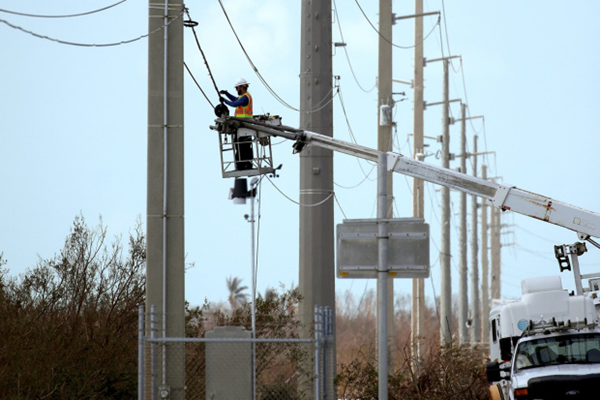THE
WALL STREET JOURNAL.
Business
Does Verizon Really Pay the Typical Worker 60% More Than AT&T?
New figures show
differences in how firms operate, limitations of SEC disclosure
requirements
|

An AT&T worker repairs lines in
the Florida Keys in September. AT&T has held on to more of its
landline business than Verizon. PHOTO: AL DIAZ/MIAMI HERALD/ZUMA
PRESS |
By
Theo Francis
Updated March 28, 2018 11:50 a.m. ET
To many consumers,
Verizon Communications Inc. and
AT&T Inc. look a lot alike: two telecom giants with national
footprints that sell mobile phone, internet, landline telephone and
even television service.
To their rank-and-file workers, however, the two firms are a
world apart.
At least that is what it looks like from newly disclosed pay
figures, which show Verizon paid its median employee nearly $127,000 last year
while AT&T’s median worker made about $78,000.
Does Verizon really pay rank-and-file employees about 60% more
than its closest rival?
The gap illustrates fundamental differences in the way the rivals
operate that filter down to how workers are paid. But it also highlights some of
the limitations of a
new requirement from the Securities and Exchange Commission that U.S.
publicly traded companies disclose what they pay their median workers.
First, the differences between the two companies:
AT&T is based in Texas, where salaries
for similar jobs tend to be lower than they are in the Northeast, where Verizon
is based.
|

A Verizon Wireless store in
Chicago. Verizon owns fewer of its retail stores than AT&T does.
Photo: Christopher Dilts/Bloomberg News |
|
In addition, both firms grew out of Ma Bell’s breakup in 1984,
but since have focused to different degrees on parts of the phone business that
require different types of workers. What is now AT&T started life as
Southwestern Bell and expanded in part by acquiring other landline operators. By
contrast, Verizon—heir to Northeastern “Baby Bells” as Bell Atlantic—focused
more on expanding wireless service, and in recent years
has shed some wireline assets.
That leaves AT&T with more so-called pole climbers—the
installation, repair and maintenance workers that make up much of the telecom
industry—as well as more regional office staff, says Jeffrey Moore, a
telecom-industry analyst and principal of Wave7 Research.
“It’s much more of a physical business,” Mr. Moore said. “You’ve
got to have a lot of low paid people to roll trucks and establish phone
connections.”
While both firms have thousands of retail stores, many are
so-called dealer stores, owned and staffed by other firms. AT&T owns more of its
own stores: just under 40%, compared with just over 20% at Verizon, by Mr.
Moore’s figures. Retail workers tend to have lower pay.
Another factor is outsourcing. Low-wage jobs are typically the
first to be farmed out to contractors. Despite similar geographic footprints,
Verizon has a significantly smaller workforce: about 155,000 employees to AT&T’s
roughly 250,000 last year.
Moreover, Verizon reports higher revenue per employee than AT&T,
which could indicate that it simply pays contractors for much of the lower-wage
work that it does require, said Nicholas Bloom, a Stanford University economist
who studies pay patterns. “The first things on the firing lines for contracting
out are the low wage jobs.”
That leaves the mechanics of the median-pay figure itself.
First, a technical point: Companies aren’t exactly disclosing a
median pay figure, which is the point at which half their workers make more, and
half less. Rather, they are disclosing the total pay of a specific individual
identified as their median worker.
SEC disclosure rules are firm about how companies calculate the
total pay figure. It has to match the method set in regulations years ago for
calculating CEO pay.
But firms have much more leeway in identifying that median
worker. They can pick various measures of pay to line up workers from highest to
lowest, before choosing the person in the middle. Some use salary and wages
alone. Others include various combinations of overtime, commissions, cash
bonuses, equity awards, pension and 401(k) benefits, company-paid
health-insurance premiums and more.
AT&T’s approach is fairly typical, using cash compensation to
line workers up. It says in its proxy that the initial employee identified at
the median had an unusual pension benefit. So the firm instead used a different
employee with lower total pay for its calculation.
Verizon, by contrast, starts with what it calls gross earnings,
then adds estimates for company contributions to 401(k) and
supplemental-retirement plans, as well as an estimate of the present value of
any annual gains in the employee’s future pension benefits. That increases the
number of assumptions that go into the calculation.
Representatives for AT&T and Verizon generally declined to
discuss what could account for the disparity in their median pay figures. An
AT&T spokeswoman said differences in how the companies identified their median
workers could have contributed. A Verizon spokesman noted that it included
company-paid health care benefits in identifying its median employee.
“The issue is, there’s so much flexibility in how to you
calculate this,” Mr. Bloom said.
—Drew FitzGerald contributed to this article.
Write to
Theo Francis at
theo.francis@wsj.com